Contact Us
In this Department
- Fines and Payments
- Application Information
- Career Opportunities
- Patrol Division
- Background
- Building & Inspections
- Diversity & Inclusion Resources
- Projects
- Who Must Appear
- Billing Office
- Guiding Principles
- Map Room
- Code Enforcement
- Applicants
- File A Police Report
- Deferral Program Information
- Current Planning & Zoning
- Criminal Investigations Division
- Clean Storm Water Program
- Household Water Tips
- Operations Division
- Communications Department
- Employees
- Trials
- Emergency Medical Services
- Boards, Commissions, & Committees
- Flood Hazard Mitigation
- Kids & Students
- Legal Department
- Found Property List
- Plans and Studies
- Support Division
- CSO Notification
- NobleAct
- Inspections
- Noblesville Links
- Professional Standards Division
Board/Commission/Committee
- Redevelopment Commission
- Redevelopment Authority
- Economic Development Commission
- Board of Public Works & Safety
- Architectural Review Board (ARB)
- Tree Board
Link or Service
Projects
Department Home
Topics of Interest
Sewer Collection System
Noblesville Utilities – Collection System
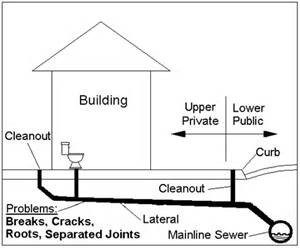
There are many different parts that make up the sewer collection system. The sanitary system (dirty water) starts with the drains inside your house or building that all connect to a lateral line on the building property. The lateral then connects to the City’s mainline that makes its way to the treatment plant. This lateral is the responsibility of the property owner. When there are blockages in the lateral, the cap on the small pipe outside the building, called the cleanout, can be removed by the owner or licensed plumber to flush or snake the lateral in order to help clear a blockage. When a lateral has a break, crack, or invasive roots causing a blockage, it could require the lateral to be dug up for repair or replacement at a larger cost to the property owner. This is why it is very important to protect your lateral from these expensive problems. Some tips to help homeowners are:
- Do not flush anything down the drain other than what naturally come out of your body and toilet paper. Avoid all sanitary products, cotton swabs, kitchen grease and oils, any form of wipe or so called “flushable” These do not disperse and bind themselves all together to form large blockages.
- Do not plant trees or bushes anywhere near your lateral, Roots seek out water sources and invade pipes.
Keeping the system running smoothly, benefits everyone that uses it. The same items that could damage the personal property of a lateral can become an even larger blockage when many users’ debris makes it into the mainline. These prohibited items could cause backups into many properties at once, damage to pipes and pumps in the system, overflows out of manholes, which could all translate into higher costs to the users.
Mainlines are installed with a slight slope to allow gravity to push the flow towards the treatment plant. When the depth of the pipe no longer allows for a slope, a lift station is built to lift the flow to a higher elevation for gravity to once again work. Noblesville Utilities has 23 lift stations in the collection system, with the majority of those stations located around the reservoir area. Lift stations usually consist of an above ground electrical control panel, two or more pumps underground, and most are inside of fenced areas.
Another part of the collection system is similar but separate from the sanitary pipes and is called the storm sewer system which conveys clear water. Storm grates along the curbs on the street, perimeter drains, and gutter drains catch rain water which then travels underground in pipes to open waterways, such as creeks, rivers and reservoirs.
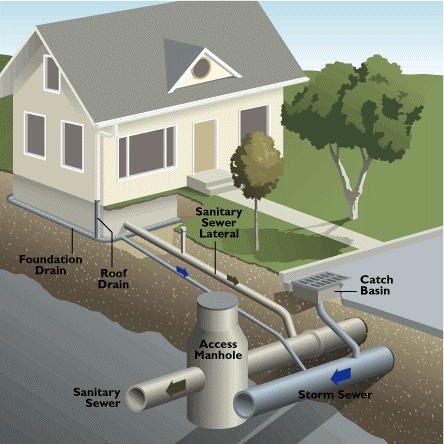
Did you know it is against the law to connect clear water to the sanitary sewer system? Sanitary sewers are engineered to be the correct size for the area it is servicing for conveying dirty water only. When clear water is introduced into the sanitary system, it overloads the system and causes sewage to surcharge out of manholes or back into building basements. Sump pump discharge is clear ground water and should be made to drain in the yard or connected to a storm system only. Some property owners may not want a wet area in their yard, but I am sure they would definitely not want a sanitary sewer to back up into their basement from an illegally connected sump pump pit and have to pay for the cleanup of such a mess of their home. Check out the link on our Utilities website called Clean Storm Water Program for information on how you can help protect your local waterways.
The City is responsible for the main sewer line under the street. The Utility has many crews to maintain proper flow throughout the system. One such crew operates a large truck that uses high pressure water to jet our sewer line from manhole access points and also vacuum back debris into a tank on the truck for proper disposal.
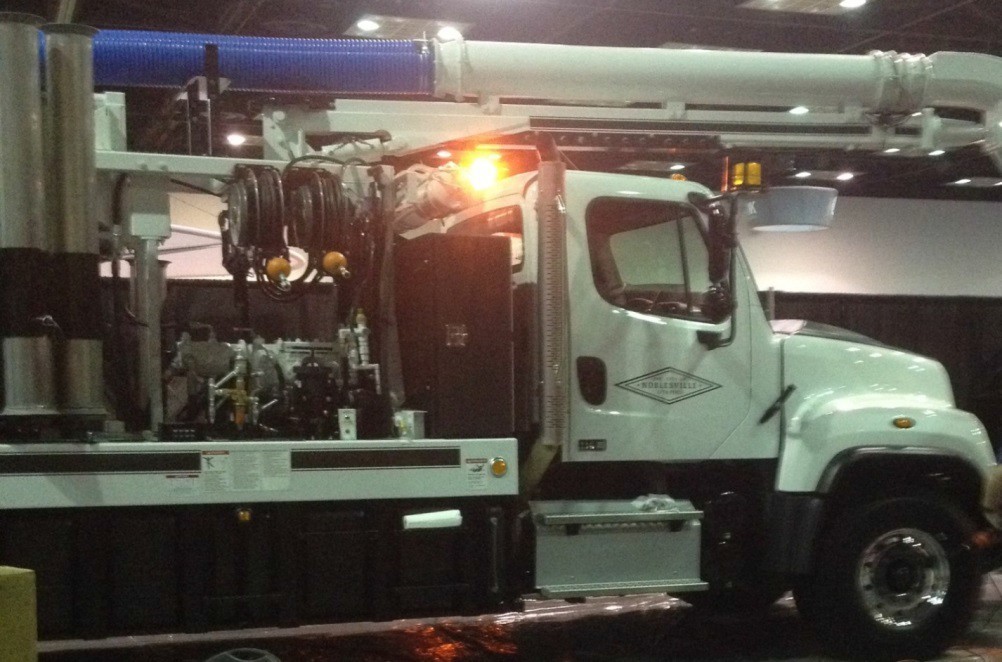
After these lines have been cleaned, the Utility then uses a camera on wheels that travels through the pipe to take still photos and video of the sewer lines.
The video and pictures are sent to the computer inside of the camera truck for review and to determine if repairs are needed.
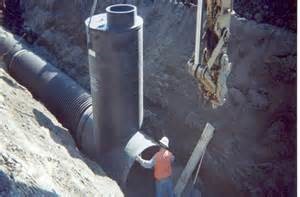
Manhole access points are needed throughout the collection system to be able to clean the system. Sometimes the tube-like structures that make up the manholes get cracked or damaged and may cause unwanted flow to enter the system. Other times, developers or property owners cover up the manholes with landscaping and sod. When these problems occur, the City sends out the manhole/mainline crew to repair or raise the top of the manhole for proper function and access. Without proper access, a property owner could have a backup, and the Utility would not be able to clear the backup, causing the owner damages.
Mainlines and Manhole structures are put into the ground long before buildings and homes are built. There is no way to create a brand new manhole in one afternoon while the property owner is away. If you were unaware of a manhole on your property, and return to find one visible, a small concrete ring has just been added to the top in order to make it visible and accessible.
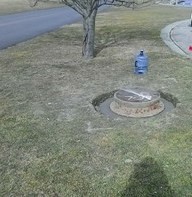
Before digging in an area, it is imperative to call in a locate so that you don’t injure yourself or cause interruption by breaking a utility service line. The City has a crew that locates Utilities in Noblesville for anyone that may be doing work in our area that requests a locate. To find the many utilities buried underground, a wand like tool is used, similar to tuning into your favorite radio station.
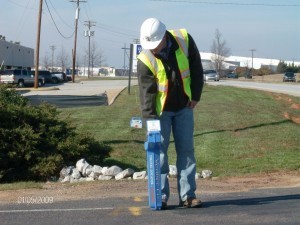
Each station transmits a different signal, and locators are like a radio designed to pick up those signals. These signals help identify the exact location of an underground utility. Many utility lines give off a charge or transmit a signal, and in most cases each line has a different charge or signal just like radio stations. However, some lines do not give off a charge or transmit a signal. In these cases, a transmitter can be used to induce a signal onto a metal line, which allows the locator to pick up the signal. Once the right signal is read, small flags and paint marks are put into the ground to show the worker what is there. Each utility is represented by a different color: gas = yellow, phone/cable = orange, electrical = red, water = blue, sewage = green, temporary survey = pink, proposed construction = .
